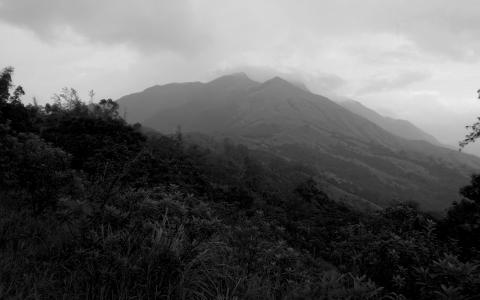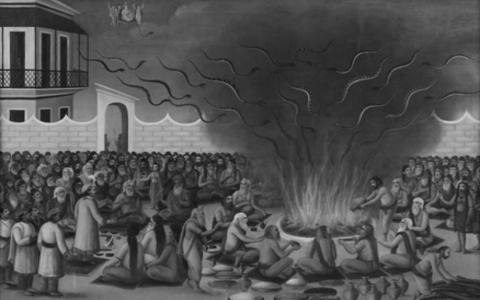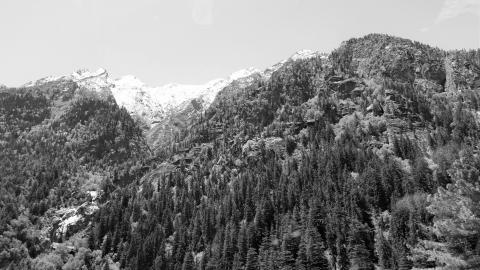July 2017

One of the fascinating things about travelling across India especially on our national highways is the sheer number of milestones of history, seemingly casually erected so elevated and steep that one is compelled to pause or stop and listen to their stories. We’re reminded of the scene in Dr. S L Bhyrappa’s Aavarana where Razia (or Lakshmi) mulls at a train station about visiting the temples destroyed in the vicinity and learning all about their...

A paper titled “The Perspective of Practical Vedānta in the Works of M. Hiriyanna” was presented by Arjun Bharadwaj at the international conference “New Frontiers in Sanskrit and Indic Knowledge” (NFSI) on 12th June 2017 organized by the Chinmaya Vishwavidyapeeth. The current article contains excerpts from the paper.
Hiryanna seems to subscribe to the traditional view of sarva-mukti [1] (simultaneous liberation for all) and places videha-mukti [...

Kālidāsa is known as the master of similes. The Sanskrit tradition has proclaimed it as ‘Upamā Kālidāsasya.’ The variety, depth and appropriateness of his similes remains unsurpassed to this day. A study of his similes is itself an education in many branches of knowledge. Instead of confining ourselves strictly to the similes, we can look at the superset called sādṛṣyamūlālaṅkāra. Dṛṣṭānta (Analogy) and atiśayokti (hyperbole) also fall into the...

Adhyāyas 4-12. Pauloma-parva
The adhyāyas from 4 to 12 form the Pauloma-parva. Just like the anukramaṇikā (prologue), this section starts with a prose passage.
रोमहर्षणपुत्र उग्रश्रवाः सूतः पौराणिको नैमिषारण्ये शौनकस्य कुलपतेर्द्वादशवार्षिके सत्रे |
(Sūta-paurāṇika Ugraśrava, the son of Romaharṣaṇa during the twelve year long satra conducted by Śaunaka in the Naimiṣāraṇya,....)
This is followed by a few more lines of prose and verses. When...

III
We shall now turn to the role of idiomatic language in poetry. As we all know, idiom is the life of any language. It is the hallmark of a great poet to employ idioms in his verses. At the same time, this is also a challenge, as idioms are generally easier to fit into a prose passage. Here are a few examples from languages other than Sanskrit:
कैअवरिहिअं पेम्मं णत्थि व्विअ मामि माणुसे लोए | ह होइ कस्स विरहो विरहे होत्तामि को जिऐ ||...

The focus of this article, as evident from the title, is on the role played by meter, idiom, diction and figures of speech—features that enrich the total aesthetic appeal of a poem—in classical Indian poetry. Art is created when emotions are sublimated and imagination is brought into action. Emotions moulded by imagination (pratibhā)—with or without the assistance of erudition (vyutpatti) and practice (abhyāsa)—result in a work of art, while...

A paper titled “The Perspective of Practical Vedānta in the Works of M. Hiriyanna” was presented by Arjun Bharadwaj at the international conference “New Frontiers in Sanskrit and Indic Knowledge” (NFSI) on 12th June 2017 organized by the Chinmaya Vishwavidyapeeth. The current article contains excerpts from the paper.
The previous article defined the three cardinal values – Truth, Goodness and Beauty – and their relation to the ideal - mokṣa. It...

Perhaps there is no other poet in Sanskrit or any other Indian language who has described the mythology, knowledge, geography, flora and fauna of our country in such vivid and intimate detail as Kālidāsa has. This is the primary reason why he should be our national poet. For him, no place was just a mass of land; no river just a mass of water; no city just a mass of people; and no Indian value just a thought. This can be seen from many...

The third adhyāya of the Ādi-parva contains the ‘Pauṣya’(upa)parva. The Sūta, Ugraśrava tells the story of Uttaṅka. After completing his studies, Uttaṅka sets out to bring the earrings of King Puṣya’s consort as guru-dakṣiṇa (a token of gratitude to his guru). After acquiring them from the queen, on his way back through a forest, he is harassed by Takṣaka , the king of serpents. Enraged, Uttaṅka goes to King Janamejaya and reminds him that his...

5. Mālavikāgnimitram
This is probably Kālidāsa’s first drama. This is proved by the first few verses in this drama, where he salutes earlier poets and humbly draws the attention of the audience to himself. The story is quite simple. The princess of Vidarbha, Mālavika, while on her way to King Agnimitra, gets lost in the forest because of an accident. The chief of the forest outpost finds her and assigns her to the services of the queen’s palace...
